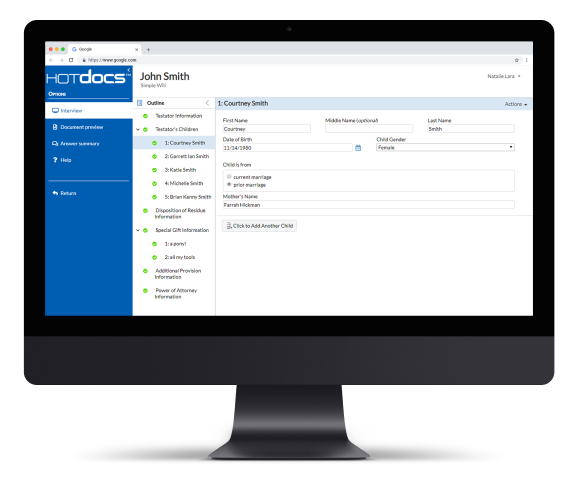
What is an Interactive Form?
What is an interactive form? Trust us, you’ve seen one. If you’ve ever filled out a form online and that form started responding back to you, asking questions, you’ve dealt with an interactive form.
Simply put, interactive forms are electronic documents that respond to input from a user. They’re programmed to ask follow-up questions in order to achieve completeness and accuracy and are most often used to speed up and automate the manual process of mass document preparation.
The interactive forms that you come into contact with daily can be quite simple, designed to accomplish relatively uncomplicated tasks like making a purchase. However, for service organizations like law firms, insurance companies, and banks, interactive forms are built around the experience of gathering and organizing immense amounts of data to automatically populate documents.
Tools for building specialized interactive forms are fairly common among software applications such as Business Process Management (BPM) suites and contract management applications. There are also vendors specializing in general use software that can design interactive forms for a variety of scenarios. But, the form creation process can be complicated, and so can the process of connecting those forms to whatever document creation software you use (like MS Word).
Your best bet is to search for document automation software with built-in interactive forms that integrate with all the common word processors.

Want to see document automation software in action?
HotDocs is the market-leading provider of document automation software. Get your free demo today!
Not all interactive forms technology is created equal
While there are a lot of good systems out there offering varying levels of interactive forms capabilities, the most powerful applications are known as document automation systems (a.k.a., document assembly systems). HotDocs, the global leader in document automation software, is the prime example.
Head and shoulders above the competition, HotDocs employs an enterprise-grade document automation stack of integrated technologies that can gather and parse data with enough precision to produce transaction-ready legal documents from a single interview.
By anticipating, based on human experience, the kind of information that often gets left out of in-person interviews, HotDocs saves incredible amounts of time that would otherwise be spent going back for second and third interviews to gather additional information.
What’s different about HotDocs forms?
 Where most systems focus on the data being collected, HotDocs focuses on asking questions designed to mirror the business logic behind the documents in question.
Where most systems focus on the data being collected, HotDocs focuses on asking questions designed to mirror the business logic behind the documents in question.
Rather than taking a data-first approach and focusing on simply putting data into boxes, a document-first solution like HotDocs focuses on the needs of the document and on what it will be expected to help people accomplish later on.
Similar to a conversation with an intuitive person trained to listen for and respond to certain cues, HotDocs can respond to input with an extra question or even a nest of questions, establishing context that will either shape a better answer at the moment or provide context that will prove helpful downstream.
And it’s not just about documents. The power and flexibility of HotDocs interview functionality isn’t restricted to the creation of documents; there are many other environments in which intuitive, question-generating software can be useful. For instance, in workflow management, it can ask questions designed to make sure projects are all buttoned up with no loose ends.
Want to learn more about how HotDoc interactive forms work? Instantly download our whitepaper, Building Interactive, Data-Gathering Forms for BPM-Defined Workflows
Got it. But what do document automation systems do?
It’s hard to describe in a single blog something a brand like HotDocs has put twenty years into perfecting. But to put it briefly, document automation software, using interactive forms, asks all the right questions in just the right order, so that every aspect of a legal document, loan application, or whatever the final output is, is executed in a way that enables that final output to do its job without having to go back and fill in information gaps.
Essential boilerplate language, variable conditional language, language that needs to be repeated, and many other nuances are taken into account by the software designers so that the software will ask all the right questions in order to make an interview (one person’s interaction with the software) as productive as it can possibly be.
If you just need to fill in two or three pieces of standard information in order to make your business run, just about any interactive forms technology should get the job done. But if you’re a law firm that needs transaction-ready documents or a business that relies on other complex documentation or a multifaceted workflow, you need the kind of intuitive document automation software you get with state-of-the-art technology like HotDocs.